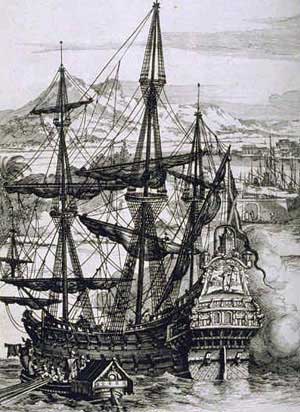Trade winds
Trade winds are a system of persistent, prevailing winds that are found in the Earth's equatorial region, blowing mainly from the northeast in the Northern Hemisphere and from the southeast in the Southern Hemisphere. These winds are part of the larger atmospheric circulation system, playing a crucial role in the Earth's climate and weather patterns. The concept of trade winds has been significant in maritime history, aiding the navigation and exploration of the world's oceans.
Origins and Characteristics[edit | edit source]
The trade winds are caused by the Earth's rotation and the differential heating of the Earth's surface. The Sun heats the equator more than the poles, creating areas of high and low pressure. This difference in pressure causes air to circulate in a pattern known as the Hadley Cell. In the Hadley Cell, warm air rises near the equator, moves toward the poles at high altitudes, cools and sinks at about 30 degrees latitude, and then flows back towards the equator at the surface. The Earth's rotation deflects these surface winds to the right in the Northern Hemisphere and to the left in the Southern Hemisphere, due to the Coriolis effect, creating the northeast and southeast trade winds.
Geographical Distribution[edit | edit source]
The trade winds blow predominantly from the northeast in the Northern Hemisphere and from the southeast in the Southern Hemisphere. They are most consistently found between the latitudes of 30° N and 30° S. This belt where the trade winds are found is known as the "trade wind belt." The consistency and reliability of these winds have historically made them extremely important for ocean navigation, particularly before the advent of powered ships.
Impact on Climate and Weather[edit | edit source]
Trade winds have a significant impact on the world's climate and weather patterns. They contribute to the El Niño-Southern Oscillation (ENSO), a periodic variation in winds and sea surface temperatures over the tropical eastern Pacific Ocean. The trade winds also play a crucial role in the formation of tropical rainforests near the equator and deserts located at 30 degrees latitude, areas where the sinking air of the Hadley Cell becomes dry and warm. Furthermore, these winds are responsible for the movement of tropical cyclones in the Atlantic and eastern Pacific Oceans.
Historical Significance[edit | edit source]
The trade winds were crucial for the age of sail, from the 15th to the 19th century, enabling European explorers to navigate the oceans and establish trade routes to the Americas, Africa, and Asia. The reliability of the trade winds allowed for relatively straightforward passage across the vast oceans, contributing to the colonization and globalization processes that shaped the modern world.
Current Relevance[edit | edit source]
Today, the trade winds continue to influence global climate and weather. Understanding these winds is essential for predicting weather patterns, especially for island nations in the trade wind belt. Additionally, the trade winds are being explored for renewable energy sources, such as wind power, due to their consistent speeds and directions.
Search WikiMD
Ad.Tired of being Overweight? Try W8MD's physician weight loss program.
Semaglutide (Ozempic / Wegovy and Tirzepatide (Mounjaro / Zepbound) available.
Advertise on WikiMD
|
WikiMD's Wellness Encyclopedia |
| Let Food Be Thy Medicine Medicine Thy Food - Hippocrates |
Translate this page: - East Asian
中文,
日本,
한국어,
South Asian
हिन्दी,
தமிழ்,
తెలుగు,
Urdu,
ಕನ್ನಡ,
Southeast Asian
Indonesian,
Vietnamese,
Thai,
မြန်မာဘာသာ,
বাংলা
European
español,
Deutsch,
français,
Greek,
português do Brasil,
polski,
română,
русский,
Nederlands,
norsk,
svenska,
suomi,
Italian
Middle Eastern & African
عربى,
Turkish,
Persian,
Hebrew,
Afrikaans,
isiZulu,
Kiswahili,
Other
Bulgarian,
Hungarian,
Czech,
Swedish,
മലയാളം,
मराठी,
ਪੰਜਾਬੀ,
ગુજરાતી,
Portuguese,
Ukrainian
Medical Disclaimer: WikiMD is not a substitute for professional medical advice. The information on WikiMD is provided as an information resource only, may be incorrect, outdated or misleading, and is not to be used or relied on for any diagnostic or treatment purposes. Please consult your health care provider before making any healthcare decisions or for guidance about a specific medical condition. WikiMD expressly disclaims responsibility, and shall have no liability, for any damages, loss, injury, or liability whatsoever suffered as a result of your reliance on the information contained in this site. By visiting this site you agree to the foregoing terms and conditions, which may from time to time be changed or supplemented by WikiMD. If you do not agree to the foregoing terms and conditions, you should not enter or use this site. See full disclaimer.
Credits:Most images are courtesy of Wikimedia commons, and templates, categories Wikipedia, licensed under CC BY SA or similar.
Contributors: Prab R. Tumpati, MD




